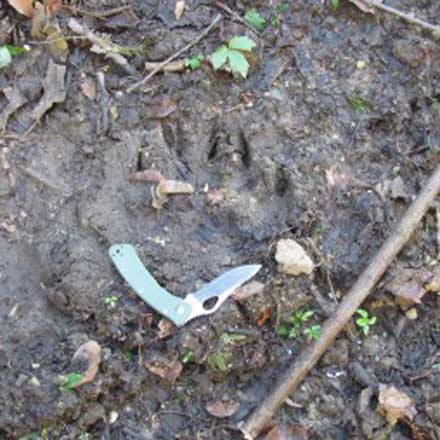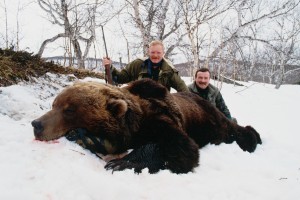
The bald eagle is America’s icon is without question a regal bird. Benjamin Franklin’s preference was the wild turkey, a choice that today’s turkey hunters would no doubt approve. Legend, or at least Hollywood, has it that Theodore Roosevelt thought the grizzly bear was a better choice. True or not, I vote with Teddy! To me, the grizzly bear is the ultimate symbol of the American wilderness and North America’s ultimate game animal.
The only problem with this train of thought is the grizzly bear doesn’t just belong to America, or even North America. He is just one race of Ursus arctos, the hump-backed, dish-faced, long-clawed bear that circumnavigates the globe in the Northern Hemisphere. From the Pyrenees Mountains of northern Spain and southern France, eastward across Asia, and further eastward to our Rocky Mountains, there are numerous races of very similar bears with extremely ill-defined boundaries. In today’s world, “grizzly country” is confined to pockets in Europe, but the great bear retains wide distribution in Asia, Alaska, and western Canada. In the “lower 48,” his numbers are growing, but he is pretty much confined to western Montana and Wyoming, centered in Yellowstone and Glacier National Parks.
It was not always so. At one time Ursus arctos was found across the majority of the great Eurasian land mass and extended across the Mediterranean into the Atlas Mountains of North Africa. In North America, he ranged far out into the Great Plains and extended all the way down the Rockies and Sierras well into northern Mexico. The fact
that his historic range stopped at the Great Plains pretty much verifies that he is actually a creature of the Old World, one of several North American species that, in theory,
crossed from Siberia to Alaska when ice ages caused the oceans to drop creating a land bridge across the Bering Strait. The last occurrence is estimated at 15 to 20 thousand years ago. So if this is true, our grizzly bear has surely been here long enough to be a citizen!
As hunters, we often try to qualify the disqualifiable, so we have long made a distinction between the Alaskan brown bear and the interior grizzly. From our standpoint, this
makes sense. Alaska’s coastal bears grow larger on a protein-rich diet of salmon and also have a shorter hibernation period (and thus longer growing period) because of the
warm-water, Japanese currents. Interior bears have a harder time making a living and...
are generally smaller. Honestly, the bears don’t know the difference. Hunters’ record books have to establish boundaries. So in Alaska, bears wander at will back and forth across the line, one day brown bears and the next day grizzlies. Coastal British Columbia also has large-bodied, fish-fed bears; we call them grizzlies, and it’s no coincidence that some of the largest grizzlies come from coastal B.C.!

But we maintain the distinction, and it makes sense from a hunting standpoint as well. Because of better and, at least seasonally, more concentrated food sources, bear populations are much denser in coastal Alaska than in the interior. So hunting the Alaskan brown bear is generally easier and more successful than hunting the interior grizzly where populations are much less dense, and the bears are more scattered in what can be extremely difficult terrain.
By the way, even our common terms of “brown” and “grizzly” can be misnomers. Color is a genetic trend, and perhaps the majority of Alaska’s coastal bears are some shade of brown, but they can run the gamut from very dark to very blonde. “Grizzly” refers to white or white-tipped guard hairs, primarily on the shoulders and hump which give the bear a frosted or “grizzled” appearance. This, too, can be regionally dominant, but coastal bears can have this grizzled look, and interior bears can also range from very, very dark to very, very blonde.
I guess I have a special affinity for these great bears; I rate them all as among the most spectacular animals in the world, and reckon they should place very high on any listing of the world’s great game animals however we classify them. Over the years, I’ve been pretty lucky with the big bears. One of my first great trophies, at least in my estimation, was my first grizzly, taken in the Kootenays of southeastern B.C. in 1974. It was not a big bear. Most interior grizzlies are not big bears, but it stood for many years as “my grizzly.”
I was pretty lucky with coastal bears, too, at least initially. Back in 1981, on the Alaskan Peninsula, I shot a huge brown bear on my first hunting day....
Subsequent attempts haven’t been quite so successful! A decade later, when Kamchatka opened on the Siberian side, I took another very large coastal bear. A bear I wanted very badly, one that continued to elude me, was a really big interior grizzly. Over the years, I made several attempts during which I came to the conclusion that hunting the interior grizzly is much more difficult and far more uncertain than hunting the coastal brown bear!
Over time, the search focused on Arctic Alaska, northwest of Kotzebue and southwest of the Brooks Range. Those bears grow large in the body and are famous for long,
luxurious fur. I was in the right place, and I was sure I was with the right guy, Master Guide Dave Leonard of Mountain Monarchs of Alaska. But I still had to be there at the right time, when the bears were just coming out of their dens and snow conditions allowed travel. It took three tries before we made our way on snowshoes, taking a wonderful old bear off a moose kill.
Master Guide Dave Leonard of Mountain Monarchs of Alaska
My problem now is that I’m pretty much done. In the 90s, I made a couple of unsuccessful attempts for another Alaskan brown bear, but today I realize that I really don’t need another one, and I’m equally sure that I won’t take another American grizzly bear. But I love to hunt the big bears, so the saving grace lies in the fact that they are a worldwide family. Last year, on the second attempt, I shot a very nice European brown bear in Romania. Yes, he’s the same hump-backed, dish-faced, long-clawed bear, so I’m done in Europe as well. But there are a couple of other spots where interior grizzlies might be hunted in Asia. Whether I’ll get there or not doesn’t matter; at least there are still some possibilities!